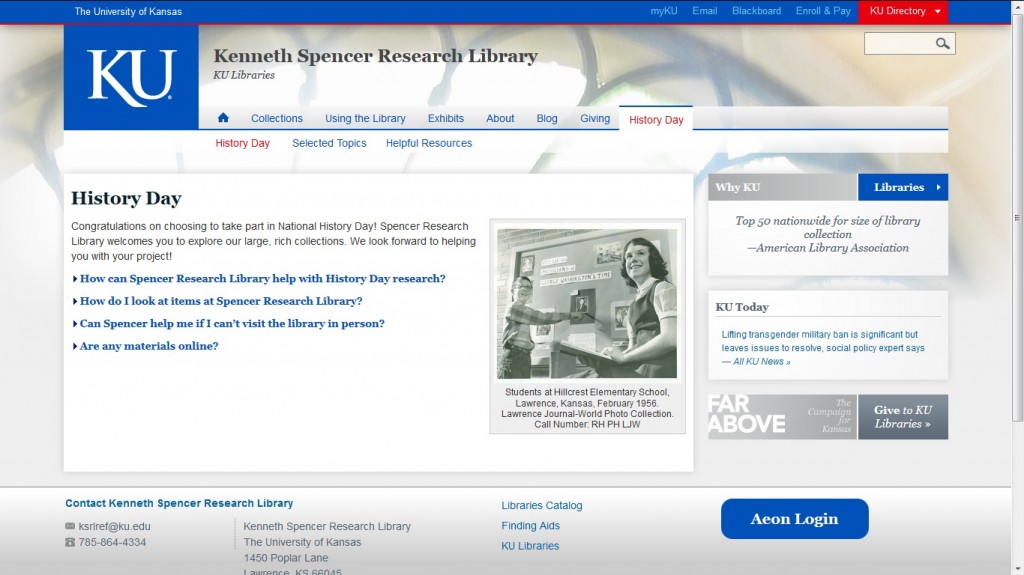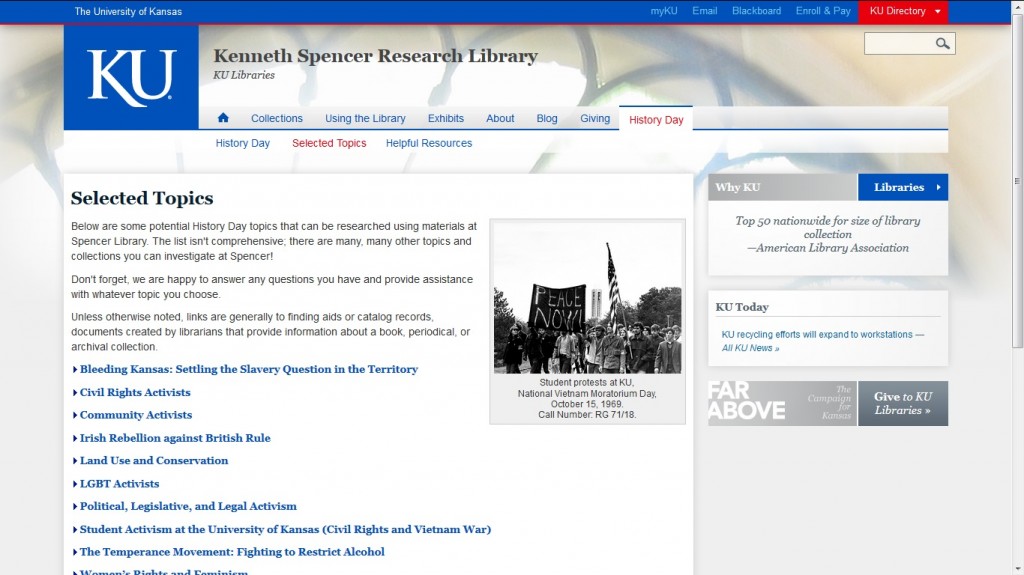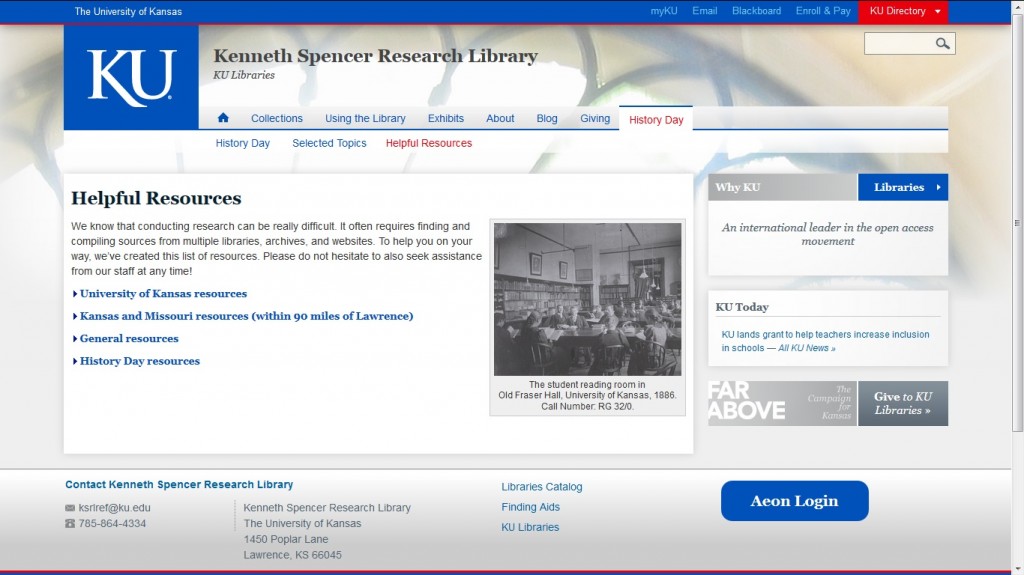July 4th, 2016 Music! Races! Lemonade! Processions! In honor of the Fourth of July, here are three broadsides from the late 1800s publicizing local celebrations.

Broadside, Fourth of July celebration, Jarbalo, Kansas, 1888.
Call Number: RH Q52. Click image to enlarge.

Broadside, Fourth of July celebration,
Springfield, Missouri, circa 1890-1899.
Call Number: RH Q93. Click image to enlarge.

Broadside, Fourth of July celebration, Fulton, Kansas,
possibly 1899. Call Number: RH P100. Click image to enlarge.
Meredith Huff
Building Operations and Stacks Manager
Public Services Student Assistant Supervisor
Tags: broadsides, Fourth of July, Fulton KS, Jarbalo KS, Kansas Collection, Meredith Huff, Springfield MO
Posted in Kansas Collection |
No Comments Yet »
July 1st, 2016 The staff of Spencer Research Library is pleased to announce the addition of an online resource dedicated to aiding students and teachers with National History Day (NHD) projects. Our hope is that this new web page will not only direct NHD researchers to the resources of our library, but will also make valuable connections between students, teachers, and our knowledgeable librarians, curators, and archivists.



Spencer Research Library’s new online resource for students and teachers
participating in National History Day. Click images to enlarge.
NHD began in 1974 as a small competition at Case Western Reserve University in Cleveland, Ohio, for students in sixth through twelfth grade. The program proved to be a great success, and it grew until it included not only Ohio, but the surrounding Midwestern states. Developing into a national organization by 1980, NHD moved its headquarters to the Washington, D.C., area in 1992. NHD now conducts year-round programs across the country and holds an annual national contest at the University of Maryland.
National History Day has grown from 129 students in 1974 to more than half a million students in forty-eight states today. Entering competition through their local schools, students develop entries individually or in groups. Choosing from one of five categories (Documentary, Exhibit, Paper, Performance, or Website), they compete in a series of competitions beginning at the local level; winners in each category advance to the regional, state, and national contests.
NHD’s stated mission is to provide students with a chance to study historical content, resulting in the development of research, critical thinking and improved communication skills through the study of history, and to provide educators with resources and training to enhance classroom teaching. The staff of Spencer Research Library hopes that this new web resource will provide a valuable research tool to assist with that mission.
Kathy Lafferty
Public Services
Tags: Kathy Lafferty, National History Day, Public Services, Research tips
Posted in Public Services |
No Comments Yet »
June 30th, 2016 Each week we’ll be posting a photograph from University Archives that shows a scene from KU’s past. We’ve also scanned more than 24,800 images from KU’s University Archives and made them available online; be sure to check them out!

KU campus scene, 1914-1915. Spooner Hall – then the university’s library – is seen on the right.
Old Green (now Lippincott) Hall is on the left, with Dyche Hall visible behind it.
University Archives Photos. Call Number: RG 71/0 1914/1915 Negatives: Student Activities (Photos).
Click image to enlarge (redirect to Spencer’s digital collections).
Caitlin Donnelly
Head of Public Services
Melissa Kleinschmidt, Megan Sims, and Abbey Ulrich
Public Services Student Assistants
Tags: Abbey Ulrich, Caitlin Donnelly, Campus, Dyche Hall, Green Hall, KU History, Lippincott Hall, Megan Sims, Melissa Kleinschmidt, photographs, Spooner Hall, Throwback Thursday, University Archives, University history, University of Kansas
Posted in Throwback Thursday |
No Comments Yet »
June 23rd, 2016 Each week we’ll be posting a photograph from University Archives that shows a scene from KU’s past. We’ve also scanned more than 27,700 images from KU’s University Archives and made them available online; be sure to check them out!
Last year we shared a fun aerial view of the KU campus from 1942. This week we’re sharing two more – slightly later – aerial photographs that show the site on which Spencer Research Library was built.

Aerial view of campus looking southwest from Marvin Grove, 1952.
Note the area along the top of the photograph; Naismith Drive stops at
15th Street and is undeveloped to the west.
University Archives Photos. Call Number: RG 0/24/A 1952 Prints:
University General: Campus: Campus Aerials (Photos).
Click image to enlarge (redirect to Spencer’s digital collections).
The structures just north of Strong Hall – where Spencer Research Library now stands – were four of the thirteen temporary buildings constructed just after World War II. According to a December 1946 article in the Graduate Magazine (shown below), the buildings were funded by the federal government. They were used as “extra service units needed for the flood of students,” i.e. returning veterans who had enrolled at KU.

Buildings 5, 6, 7, and 8 shown on this map are the ones shown in the photograph above.
Note the description of Building 5 in the article. Graduate Magazine, December 1946.
University Archives. Call Number: LH 1 .K3 G73 1946-1947. Click image to enlarge.

The site of Spencer Research Library flanked by Strong Hall and the Campanile, 1966.
Construction of the library lasted almost two years and began soon after this photo was taken.
The library was dedicated in November 1968. University Archives Photos.
Call Number: RG 0/24/A 1966 Prints: University General: Campus: Campus Aerials (Photos).
Click image to enlarge (redirect to Spencer’s digital collections).
Caitlin Donnelly
Head of Public Services
Melissa Kleinschmidt, Megan Sims, and Abbey Ulrich
Public Services Student Assistants
Tags: Abbey Ulrich, Caitlin Donnelly, Campanile, Campus, KU History, Megan Sims, Melissa Kleinschmidt, Memorial Carillon and Campanile, Memorial Drive, photographs, Strong Hall, Strong Hall Annex, Throwback Thursday, University Archives, University history, University of Kansas, World War II
Posted in Throwback Thursday |
No Comments Yet »
June 20th, 2016 Last week Spencer Research Library hosted a workshop on the care and identification of photographs, taught by photograph conservator Gawain Weaver. I was fortunate to attend the four-day workshop along with three other fellow Spencer staff members from Conservation, Public Services, and Processing, as well as archivists and conservators from Missouri, Texas, and elsewhere in Kansas.
Our group met in Spencer’s Johnson Room and jumped right into things on day one by preparing paper to make our own salt prints. We coated paper first in a sodium chloride solution and, once dry, in a silver nitrate solution, then we placed leaves on the coated paper and exposed them in the sunlight over our lunch break. This simple exercise was a fun and engaging way to demonstrate the fundamentals of photographic chemistry.

The salt print I made in the workshop…it isn’t pretty, but the exercise was very useful!
Over the four days, we divided our time between Gawain’s incredibly information-packed lectures on the history of photographic and photomechanical processes, and lively hands-on sessions examining examples of many of the processes we’d learned about. The workshop fee included a small 60x-100x handheld microscope and a binder filled with the lecture slides, reference guides for identifying various processes, articles and recommended reading lists, and lots more useful information. Participants also had the option to purchase a sample set of photographic and photomechanical prints – a great addition to an archivist’s or conservator’s reference library.

This microscope is small, inexpensive, and very handy for identifying photographic & printmaking processes.

Photograph sample set of eighteen different photographic and photomechanical prints.
In addition to covering photographic history and technique, Gawain also discussed digital prints and issues of photograph deterioration, storage conditions, and proper housings. I enjoyed this workshop a great deal, and I came away with a clearer understanding of how photographs are made as well as greater confidence in my ability to identify photographic processes and to better address the particular preservation needs of photographs in the collections I work on. Many of the guides and resources in the workshop packet are available for purchase or to download for free from Gawain’s website, along with links to many more resources and information about this and other workshops that Gawain offers.
Angela Andres
Special Collections Conservator
Conservation Services
Tags: Angela Andres, Gawain Weaver, photographs, photomechanical, salt print, workshop
Posted in Conservation, Events, Processing and Cataloging, Public Services |
No Comments Yet »













